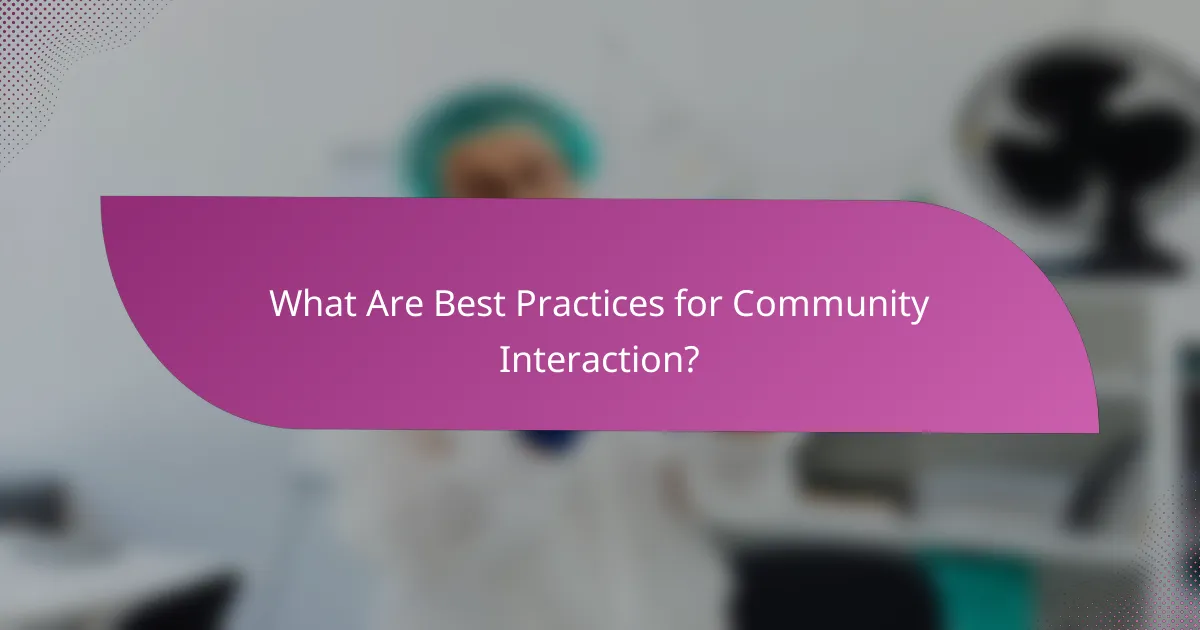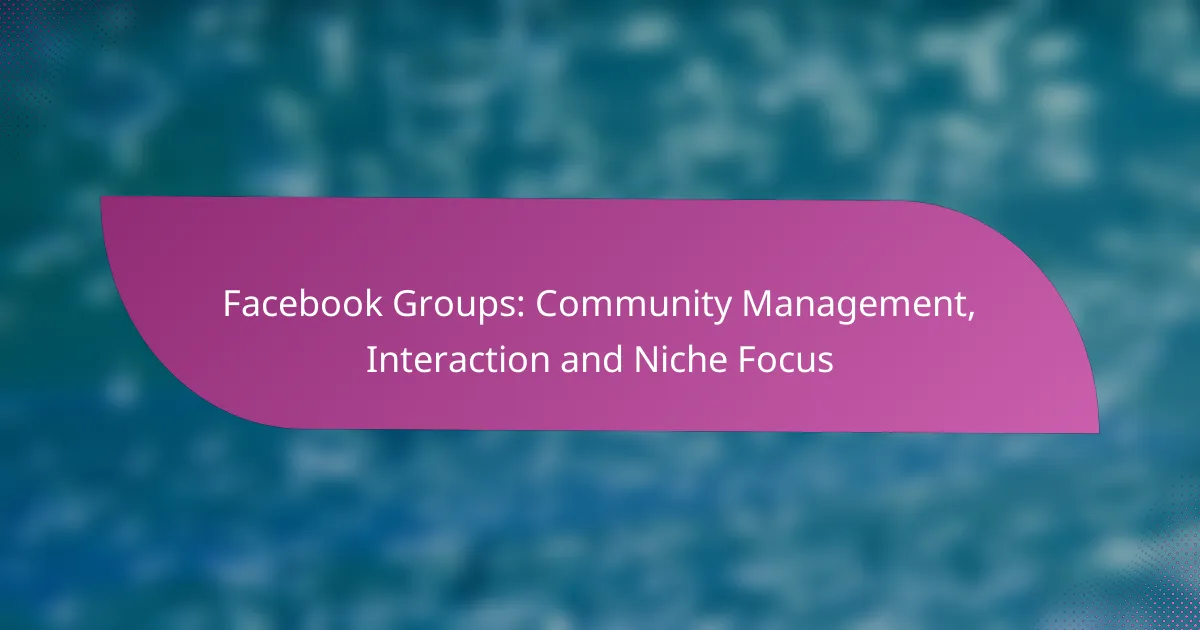Managing a Facebook Group effectively requires a focus on member engagement, clear guidelines, and a supportive environment. By leveraging moderation tools and insights, you can enhance interaction while maintaining a strong niche focus that attracts like-minded individuals. Implementing strategies such as member introductions and live Q&A sessions can further enrich the community experience.

How to Effectively Manage Facebook Groups?
Effectively managing Facebook Groups involves engaging members, setting clear guidelines, and creating a positive atmosphere. By utilizing insights and moderation tools, you can foster community interaction and maintain focus on your group’s niche.
Utilize group insights for engagement
Group insights provide valuable data about member activity, post engagement, and growth trends. Regularly review these metrics to understand what content resonates most with your audience and adjust your strategy accordingly.
For example, if you notice that posts about specific topics receive higher engagement, consider increasing the frequency of such content. This data-driven approach helps in tailoring discussions that keep members interested and active.
Establish clear group rules
Clear group rules set expectations for behavior and content sharing, which is essential for maintaining a respectful environment. Outline these rules in a pinned post and ensure all members acknowledge them upon joining.
Consider including guidelines on acceptable topics, posting frequency, and consequences for rule violations. This clarity helps prevent misunderstandings and fosters a sense of accountability among members.
Foster a welcoming environment
A welcoming environment encourages new members to participate and share their thoughts. Start by introducing new members in a dedicated post and encourage existing members to greet them.
Additionally, actively engage with members’ posts by liking and commenting. This interaction not only builds rapport but also motivates others to contribute, creating a vibrant community atmosphere.
Leverage moderation tools
Facebook provides various moderation tools to help manage group content effectively. Utilize features like post approval, keyword filters, and member reporting to maintain quality discussions and prevent spam.
Regularly review flagged content and member reports to ensure timely responses. This proactive approach helps maintain a healthy group dynamic and reassures members that their concerns are taken seriously.
Schedule regular content
Consistent content scheduling keeps the group active and engaged. Plan a content calendar that includes regular posts, discussions, and themed days to encourage participation.
For instance, you might designate Mondays for member spotlights, Wednesdays for topic discussions, and Fridays for sharing resources. This structure helps members know when to expect new content, increasing overall engagement.

What Are Best Practices for Community Interaction?
Best practices for community interaction in Facebook Groups focus on fostering engagement and building relationships among members. Implementing strategies like member introductions, live Q&A sessions, and polls can significantly enhance participation and create a vibrant community atmosphere.
Encourage member introductions
Encouraging member introductions is a foundational practice for building community. Create a dedicated post or thread where new members can share a bit about themselves, such as their interests or reasons for joining the group. This helps establish connections and makes newcomers feel welcomed.
Consider pinning an introduction post at the top of the group for easy access. Regularly remind members to introduce themselves, especially when new members join. This can lead to more meaningful interactions and a stronger sense of belonging.
Host live Q&A sessions
Live Q&A sessions are an effective way to engage members and provide valuable information. Schedule these sessions regularly, perhaps monthly, and promote them in advance to maximize attendance. Choose relevant topics that resonate with your community’s interests.
During the session, encourage members to ask questions in real-time, fostering a dynamic and interactive environment. Consider inviting guest experts to add variety and depth to the discussions, which can attract more participants and enhance the group’s value.
Utilize polls for feedback
Utilizing polls is a straightforward method to gather feedback and gauge member preferences. Create polls to ask about topics for future discussions, group activities, or even member satisfaction. This not only involves members in decision-making but also helps tailor content to their interests.
Keep polls simple and concise, using clear language to ensure understanding. Regularly review poll results and share outcomes with the group to show that their input is valued and taken into account.
Share user-generated content
Sharing user-generated content (UGC) encourages members to contribute and feel invested in the community. Highlight posts, photos, or stories from members that align with the group’s theme. This not only showcases member contributions but also inspires others to engage.
Establish guidelines for UGC to ensure quality and relevance. Consider creating a monthly feature where you spotlight a member’s contribution, which can motivate others to share their experiences and insights.

How to Choose a Niche for Your Facebook Group?
Choosing a niche for your Facebook group involves identifying a specific area of interest that resonates with a target audience. A well-defined niche helps attract members who are genuinely interested in the topic, fostering engagement and community growth.
Identify audience interests
Understanding your audience’s interests is crucial for selecting a niche. Conduct surveys, engage in discussions, or analyze existing groups to gather insights about what potential members are passionate about. Look for common themes or topics that spark excitement and conversation.
Utilize Facebook’s audience insights tool to explore demographics and interests related to your potential niche. This data can help you tailor your group’s focus to better align with what your audience values.
Analyze competitor groups
Examining competitor groups can provide valuable information on successful niche strategies. Identify groups that are similar to your intended niche and assess their engagement levels, member interactions, and content types. Take note of what works well and what doesn’t.
Look for gaps in the market where existing groups may be lacking. This could be in terms of content quality, community interaction, or specific subtopics that are underrepresented. Positioning your group to fill these gaps can enhance its appeal.
Evaluate market demand
Assessing market demand is essential for ensuring your niche has a viable audience. Use tools like Google Trends to gauge interest over time and explore related keywords that indicate potential growth. A niche with consistent or increasing search interest is more likely to attract members.
Consider the size of the target audience and their willingness to engage. A niche with a dedicated but smaller audience can often be more rewarding than a broad topic with high competition. Aim for a balance between passion and market viability to ensure long-term success.

What Tools Enhance Facebook Group Management?
Effective Facebook group management relies on a variety of tools that streamline operations, enhance engagement, and provide insights. Utilizing the right tools can significantly improve your group’s performance and member satisfaction.
Facebook Group Insights
Facebook Group Insights is a built-in analytics tool that provides valuable data about group activity and member engagement. It helps administrators track metrics such as member growth, post reach, and interaction rates, allowing for informed decision-making.
To maximize the benefits of Insights, regularly review the data to identify trends and adjust your content strategy accordingly. For example, if you notice that certain types of posts generate higher engagement, consider increasing their frequency.
Canva for graphics
Canva is a user-friendly graphic design tool that enables group admins to create visually appealing posts, banners, and promotional materials. With a variety of templates and design elements, Canva helps maintain a professional look for your group.
When using Canva, focus on consistency in branding by using similar colors and fonts across your designs. This can enhance your group’s identity and make posts more recognizable to members.
Zapier for automation
Zapier is an automation tool that connects different apps and services, allowing for seamless workflows. For Facebook groups, it can automate tasks such as posting updates across platforms or managing member sign-ups, saving time and reducing manual effort.
To effectively use Zapier, identify repetitive tasks that can be automated. For instance, you can set up a Zap to automatically welcome new members with a personalized message, enhancing their initial experience in the group.

What Are the Benefits of Facebook Groups for Businesses?
Facebook Groups offer businesses a unique platform to foster community engagement, enhance brand loyalty, and facilitate direct communication with customers. By creating a dedicated space for discussions, businesses can build stronger relationships and gain valuable insights into customer preferences.
Increased customer loyalty
Facebook Groups can significantly boost customer loyalty by providing a sense of belonging among members. When customers feel part of a community, they are more likely to engage with the brand and remain loyal over time.
To cultivate loyalty, businesses should encourage active participation by sharing exclusive content, hosting events, or offering special promotions within the group. For example, a clothing brand might share sneak peeks of new collections or offer discounts to group members, reinforcing their connection to the brand.
Monitoring group interactions is crucial. Respond promptly to questions and feedback, and recognize loyal members to foster a positive environment. This approach not only strengthens relationships but also encourages word-of-mouth referrals, further enhancing customer loyalty.
